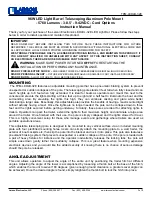
5
declination axis. This is because the telescope cannot be
repositioned as it can when tube rings are used.
Assuming you will be using tube rings, we will first balance the
telescope with respect to the R.A. axis, then the Dec. axis:
1. Keeping one hand on the telescope optical tube, loosen the
R.A. lock knob. Make sure the Dec. lock knob is locked, for
now. The telescope should now be able to rotate freely
about the R.A. axis. Rotate it until the counterweight shaft is
parallel to the ground (i.e., horizontal).
2. Now loosen the counterweight lock knob and slide the
weight along the shaft until it exactly counterbalances the
telescope (Figure 3a). That’s the point at which the shaft
remains horizontal even when you let go of the telescope
with both hands (Figure 3b). If you position the counter-
weight all the way at the end of the shaft (near the retaining
bolt and washer) and it still does not counterbalance the tel-
escope, you will need to purchase an additional
counterweight. Retighten the counterweight lock knob. The
telescope is now balanced on the R.A. axis.
3. To balance the telescope on the Dec. axis, first tighten the
R.A. lock knob, with the counterweight shaft still in the hori-
zontal position.
4. With one hand on the telescope optical tube, loosen the
Dec. lock knob. The telescope should now be able to rotate
freely about the Dec. axis.
5. Loosen the tube ring clamps a few turns until you can slide
the telescope tube forward and back inside the rings (this
can be aided by using a slight twisting motion on the optical
tube while you push or pull on it). Position the telescope so
that it remains horizontal when you carefully let go with both
hands. This is the balance point for the Dec. axis (Figure
3d). Before clamping the rings tight again, rotate the tele-
scope so that the eyepiece is at a convenient angle for
viewing.
The telescope is now balanced on both axes. Now when you
loosen the lock knob on one or both axes and manually point
the telescope, it should move without resistance and should
not drift from where you point it.
5. Setting Up and Using
the Equatorial Mount
When you look at the night sky, you no doubt have noticed
that the stars appear to move slowly from east to west over
time. That apparent motion is caused by the Earth’s rotation
(from west to east). An equatorial mount (Figure 2) is
designed to compensate for that motion, allowing you to easi-
ly “track” the movement of astronomical objects, thereby
keeping them from drifting out of the telescope’s field of view
while you’re observing.
This is accomplished by slowly rotating the telescope on its right
ascension (R.A.) axis, using only the R.A. slow-motion cable.
But first the R.A. axis of the mount must be aligned with the
Earth’s rotational (polar) axis - a process called polar alignment.
Polar Alignment
For Northern Hemisphere observers, approximate polar align-
ment is achieved by pointing the mount’s R.A. axis at the
North Star, or Polaris. It lies within 1° of the north celestial pole
(NCP), which is an extension of the Earth’s rotational axis out
into space. Stars in the Northern Hemisphere appear to
revolve around the NCP.
To find Polaris in the sky, look north and locate the pattern of
the Big Dipper (Figure 4). The two stars at the end of the
“bowl” of the Big Dipper point right to Polaris.
Observers in the Southern Hemisphere aren’t so fortunate to
have a bright star so near the south celestial pole (SCP). The
star Sigma Octantis lies about 1° from the SCP, but it is barely
visible with the naked eye (magnitude 5.5).
For general visual observation, an approximate polar align-
ment is sufficient.
Level the equatorial mount by adjusting the length of the three
tripod legs.
Loosen the latitude lock t-bolt. Turn the latitude adjustment t-
bolt and tilt the mount until the pointer on the latitude scale is
set at the latitude of your observing site. If you don’t know your
latitude, consult a geographical atlas to find it. For example, if
your latitude is 35° North, set the pointer to 35. Then retighten
the latitude lock t-bolt. The latitude setting should not have to
be adjusted again unless you move to a different viewing loca-
tion some distance away.
Figure 3A, 3B, 3C, 3D: Proper operation of the equatorial
mount requires balancing the telescope tube on the R.A.
axis. (a) With the R.A. lock knob released, slide the
counterweight along the counterweight shaft until it just
counterbalances the tube. (b) When you let go with both
hands, the tube should not drift up or down. (c) With the
Dec. lock knob released, loosen the tube ring lock
clamps a few turns and slide the telescope forward or
back in the tube rings. (d) When the tube is balanced
about the Dec. axis, it will not move when you let go.
3a
3b
3c
3d


























